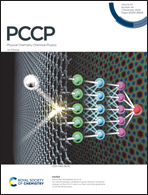Unveiling the potential of superalkali cation Li3+ for capturing nitrogen†
Abstract
The potential of the superalkali cation Li3+ for capturing N2 and its behavior in gaseous nitrogen have been theoretically studied at the MP2/6-311+G(d) level. The evolution of structures and stability of the Li3+(N2)n (n = 1–7) complexes shows that the N2 molecules tend to bind to different vertices of the Li3+ core, and that Li3+ might have the capacity to capture up to twelve nitrogen molecules in the first coordination shell. Based on natural population and molecular orbital analyses, Li3+ keeps its superatom identity in the lowest-lying Li3+(N2)n (n = 1–4) complexes. The change in the Gibbs free energies of possible fragmentation channels also indicates the thermodynamic stability of Li3+ in the (N2)n clusters when n ≤ 4. Different from the case of Li3+(H2O)n, where the electrostatic interaction is dominant, the electrostatic and polarization components are found to make nearly equal contributions to Li3+(N2)n complex formation. In addition, it can be concluded that the superalkali cation Li3+ surpasses heavy alkali metal cations in capturing N2 molecules, since it has a larger binding energy with N2 than Na+ and K+ ions.



 Please wait while we load your content...
Please wait while we load your content...